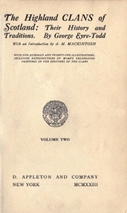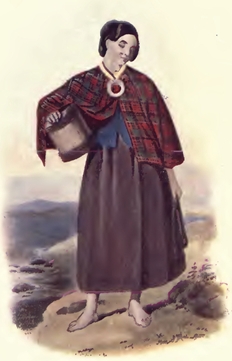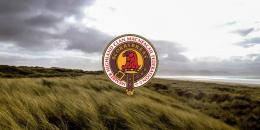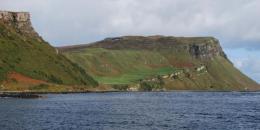Below is a very brief history of Clan MacNicol. For more information see this excellent 'official' history of the Clan): The Highland Clan MacNeacail (MacNicol): A History of the Nicolsons of Scorrybreac by W. David H. Sellar and Alasdair Maclean. David Sellar is the former Lord Lyon. If you are interested in purchasing this book, please contact us. |
|  |
|
| Of the many books written about the origin of Scottish Clans, The Highland CLANS of Scotland: Their History and Traditions by George Eyre-Todd has been a primary source of information on the Clans, to include information on Clan MacNicol. View anexcerpt from the book discussing the origins of our Clan or view the entire book. |
TIMELINES
As you read through this brief history of Clan MacNicol, take the time to understand the period of history by reviewing the historical timeline provided by the National Library of Scotland. A more accessible timeline can also be viewed which provides links to major events in Scottish history.
EARLY HISTORY OF CLAN MACNICOL
Clan MacNicol has a long and proud history of over 800 years in the Hebrides and Western Highlands. The Chief of the Clan, MacNeacail (MacNicol or Nicholson) of Scorrybreac, took his designation from his land near Portree on the Isle of Skye. The islands of Lewis and Skye where the MacNicols lived remained part of the Scandinavian kingdom of Mann (the Isle of Man) and the Isles, under the suzerainty of Norway, until 1266.
The MacNeacails, like the Macleods with whom they are closely associated, are of Scandinavian origin, and their ancestors likely belonged to the House of Ivar, a medieval Norse dynasty that had great power in the British Isles and Scandinavia. The lands in which they lived were part of the mixed Norse-Gaelic Kingdom of Man until 1266 and the remaining early records remaining of the MacNeacails place the clan among the Gallowglasses: Viking bands who had intermarried with the native Celtic population and participated in the tribal wars of early medieval Ireland. According to George Eyre-Todd, the MacNicol race was the earliest Celtic clan to inhabit the northern Hebrides.
David Sellar believes the progenitor of the Clan likely lived in the mid-13th century; however two genealogies produced in the 15th century take the earlier ancestry of the MacNeacails back to the Viking princes of 10th century Dublin. One tradition claims that one of their first settlements in Scotland was in the district of Coigach, Ullapool and Assynt on the north-western mainland: lands received from the thane of Sutherland for the service of the MacNicol chief against other bands of Viking raiders. Another tradition locates them in the Hebrides: the 17th-century Skye historian Hugh MacDonald claimed that a MacNicol was among the island chieftains killed in a rebellion against the Norwegian king Olaf the Red in c.1150. The name 'MacNicol's Castle' is given to two ancient ruins, in Coigach and in Stornoway, Isle of Lewis, appearing to corroborate these early traditions. David Sellar has speculated that the ancient arms of the MacLeods of Lewis may have been inherited from the MacNicols who had an earlier foothold in the Western Isles - the depiction of a burning mountain on a field of gold could refer to the custom of Norse chieftains lighting beacons to guide the King of Norway's ships through the Hebridean islands safe from shipwreck.
EPONYMOUS ANCESTOR
The common ancestor of the Clan is thought to be Nicail or Nicholas, a name popular in Scandinavia, who lived in the mid-13th century. Clan MacNicol of Lewis was well established by the time the MacLeods began a rise to power. The MacLeods of Lewis appear to have inherited or stolen their considerable possessions through marriage with a MacNicol heiress in the 14th century. The ancestral Nicail, therefore, probably lived in Lewis, where he and his ancestors would have served the kings of Mann and the Isles in a mixed Norse and Gaelic environment.
MACNICOL CLAN ON THE ISLE OF LEWIS
The first MacNicol Chief on record, early in the 14th century, is John, son of Nicail (Gaelic, MhicNeacail), also known as Maknakill, Mak Nakyl and Macnakild. He is recorded in the company of leading Hebridean Chiefs to include the MacDonald, MacDougall and MacRuairi descendants of Somerled (d. 1164), who had wrested control of the southern Hebrides from the king of Mann. He was courted by Edward II as a potential ally in the War of Independence. However if the account in John Barbour's poem The Bruce can be credited, he played a major role in the Scottish campaigns against the English armies in Ireland in 1316. John was perhaps the leading man on Lewis.
In the late 17th century the origin of the MacNeacails, MacLeods, Macaulays and Morrisons was documented in an historical account of Lewis. John Morisone, self-described "Indweller" of Lewis, writing sometime between about 1678 and 1688, stated that the early inhabitants of Lewis were three men from three separate races.
The first and most antient Inhabitants of this Countrie were three men of three severall races viz. Mores the son of Kenannus whom the Irish historiance call Makurich whom they make to be Naturall Sone to one of the Kings of Noruvay, some of whose posteritie remains in the land to this day. All Morisones in Scotland may challenge there descent from this man. The second was Iskair Mac.Awlay ane Irish man whose posteritie remain likvise to this day in the Lews. The third was Macknaicle whose onlie daughter Torquill the first of that name (and sone to Claudius the sone of Olipheous, who likewise is said to be the King of Noruway his sone,) did violentlie espouse, and cutt off Immediatlie the whole race of Macknaicle and possessed himself with the whole Lews and continueth to his posteritie (Macleud of Lews) dureing 13 or 14 generations and so extinct before, or at least about the year 1600 the maner of his decay I omitt because I intend no historie but a descriptione. — John Morisone, A Descriptione of the Lews. [NOTE: Claudius is an exuberant rendering of the name Leod!] |
MACNICOL WARRIORS
The MacNeacails flourished during the fourteenth century, and during that time owned much of the Isle of Lewis. It is believed that the MacNeacails formed part of two large Viking bands which ravaged the east coast of England and formed colonies under the names of Nicol and Nicolson in Northumberland and Cumberland. They also spread to the area in Scotland now known as Argyll and are said to have sent warriors to participate in the tribal wars in Ireland. Some members of the clan settled in the north of Ireland where their descendants can still be found today.
In 1314, Robert Bruce, King of Scotland, defeated Edward II of England at the Battle of Bannockburn. Soon after he sent an army commanded by his brother Edward Bruce to help the Irish fight the Anglo-Normans. In September 1315 he besieged Carrickfergus Castle and burned the town. Attempts to bring food to the castle failed and by April 1316 the starving English garrison were forced to eat animal hides. It was even rumoured that they ate 8 Scottish prisoners.

Spearman arrived to the aid of the Bruce
If the account in John Barbour's poem The Bruce can be credited, he played a major role in the Scottish campaigns against the English armies in Ireland in 1316. At the seige of Carrickfergus Castle in 1316, MacNicol and his spearmen supported Edward Bruce, brother of Robert the Bruce and High King of Ireland, against the English. In September 1316 the castle finally surrendered and Edward Bruce was able to use it as a base for further attacks on the Anglo-Normans. It remained under his control until he was killed in battle in 1318.
According to Sellar, possibly one of the earliest references to a Clan MacNeacail chief appears in a passage from John Barbour's epic The Bruce, which dates to about 1375. Sellar believes that the Maknakill recorded may be the chief, or at least a close relative to the chief of Clan MacNeacail. The passage below recounts the siege of Carrickfergus Castle in April 1316, by Edward Bruce, brother of Robert I.
For to ye fycht Maknakill yen Com with twa hundreth sper-men And yai slew all yai mycht to-wyn Yis ilk Maknakill with a gyn Wan off yar schippis four or fyve And haly reft ye men yar lif. - John Barbour, The Bruce | MacNicol came then to the fight This same MacNicol captured |
During Bruce's siege, Sir Thomas Mandeville arrived in Dublin with 15 ships in an attempt to lift the siege. Sellar argued that the arrival of Maknakill would have played a large part in preventing Mandeville from relieving the castle. Sellar is of the opinion that the "Maknakill" recorded in The Bruce may be the same as the "mak Nakyl" and "macnakild" recorded in 1306 and 1315. In 1306, letters were delivered from Edward I of England to the Earl of Ross, Lachlan MacRuairi, his brother Ruairi, and John “Mak Nakyl". In 1315, Edward II of England instructed John MacDougall of Argyll to receive Donald MacDonald, his brother Godfrey, Sir Patrick Graham and John "macnakild" into the king's peace. According to Sellar, since the MacDougalls, MacDonalds and MacRuairis mentioned were all prominent Hebridean leaders it is quite likely the “Mak Nakyl" and “Macnakild" was also a Hebridean leader.
Sellar considered the possibility that the arms may represent the MacNicols' subordinate duty as coast watchers for the early Norse kings in the Isles. The early MacLeod of Lewis arms was recorded in the mid 15th century and is blazoned Or, a rock azure in flames gules. After seeing what happened with MacNicol fortune, the MacLeods changed the rule book on inheritance. No longer would it be permitted to leave such wealth to an heiress; instead it must be passed to the closest male heir. |
|
STORNOWAY CASTLE ON LEWIS
Stornoway, located on the East coast of the Isle of Lewis is said to have begun as a Viking settlement that progressively grew in a lovely natural harbor. The Norse domination of the Hebrides lasted from about 800 to 1266 AD. The town's name is believed to come from the word 'Stjornavgr', which means “Steering Bay” in Norse. Some time in the 1100’s a castle was built proudly overlooking the town by the MacNicol Clan.
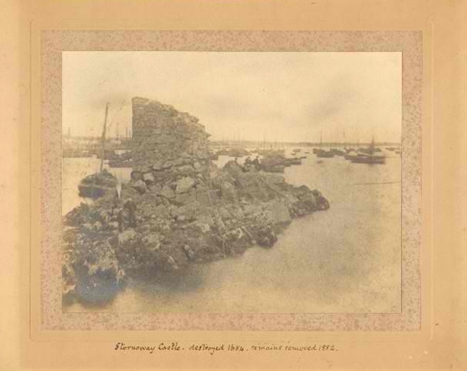
The Remains of Stornoway Castle (Castle MacNicol)
Stornoway Castle was annexed by Leod, predecessor to the MacLeods of Lewis. From about the beginning of the 14th century, the island was under the control of the Macleod's of Lewis also known as 'Siol Torquil' ('Torquil's Seed').
Clan disputes flared through the 1500s and the MacLeods remained a thorn in the side of the Edinburgh government. In 1597 James VI adopted a new approach to resolving the problems posed by his Gaelic-speaking subjects. He leased Lewis to a group of lowland businessmen called the ‘Fife Adventurers’ and authorised them to use all means necessary, including what would today be called genocide, to "root out the barbarous inhabitants".
The Fife Adventurers were beaten off by the MacLeods, and finally gave up after a third attempt in 1608. In response, James VI withdrew the MacLeod's charter in 1610 and granted Lewis to the MacKenzies of Kintail, who ran their estates from afar.
Stornoway Castle was destroyed by Cromwell’s forces in 1653 and the last remains of it removed in 1852 to provide foundations for a pier. The site of the castle is now under the ferry terminal.
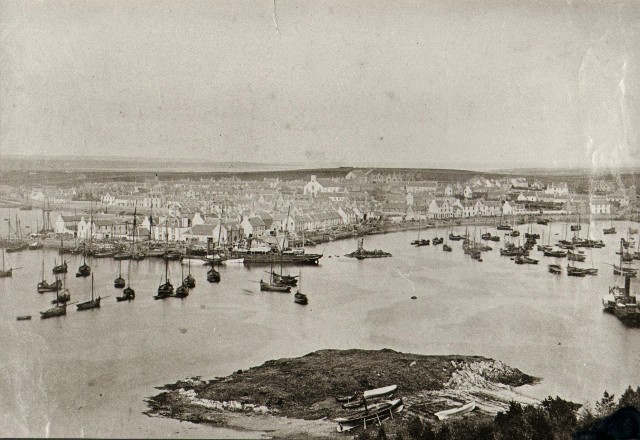 The Remains of Stornoway Castle (Castle MacNicol), center, slightly to the right
The Remains of Stornoway Castle (Castle MacNicol), center, slightly to the right
MACNICOL CLAN ON THE ISLE OF SKYE
After the loss of the Clan lands on the Isle of Lewis, the male line of the MacNeacails continued and lived on the Isle of Skye at the house of Scorrybreac. During the 16th century MacNicol of Portree was identified as one of the 16 members of the Council of the Isles, which met at Finlaggan in Islay to advise The Lord of the Isles. After the dissolution of the Lordship, the Clan followed the MacDonalds of Sleat: Malcolmuill MacNicol and his brother Nicoll took part in the feud between the MacDonalds and Macleans; both were pardoned for acts of 'fire-raising and homicide' on Mull in 1563. A century later, Sorley MacNicol was listed as one of the 'friends and followers' who had supported Sir James MacDonald in raising his clan for the service of Charles I and the Marquis of Montrose in the Civil War.
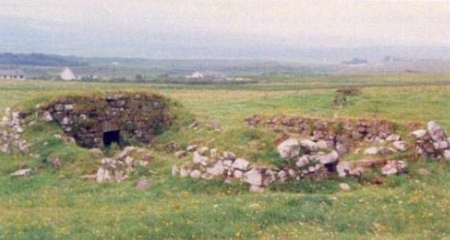 The Remains of a 19th Century home built from The Remains of a 19th Century home built fromthe Stones of the Scorrybreac House on Ben Torvaig |  A Cairn marking the site of the A Cairn marking the site of theScorrybreac House on Ben Torvaig |
17th to 19th Centuries:
The Reverend Donald Nicolson of Scorrybreac, head of the Clan at the end of the 17th century, is reputed to have had 23 children, through whom he is a common ancestor of many Skye families. Donald's attachment to the Episcopalian faith, and refusal to swear allegiance to William III after 1689 seems to have resulted in his being driven from his parish as a Non-juror and Jacobite some time after 1696. The MacDonalds of Sleat avoided action in the 1745 rebellion, and the Nicolsons did not rise as a clan for Charles Edward Stuart (“Bonnie Prince Charlie”), but tradition maintains that a band of Nicolsons fought at Culloden in the Jacobite ranks. As a cousin of the intensely Jacobite MacLeods of Raasay, the chief, John Nicolson, appears to have assisted in the concealment of Charles Edward in a cow byre on his estates. John's descendants preserved a lock of the prince's hair, and the cup out of which he drank on his night on Scorrybreac lands.
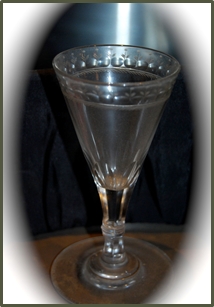 The cup that Prince Charlie drank From during his stay at Scorrybreac |  The hair of Prince Charles Edward Stuart preserved by the Chief of Clan MacNicol and passed down to the current chief |
Another man of the Clan, Donald Nicolson from Raasay, also helped to protect the Young Pretender during his flight after the defeat, and was recorded by Bishop Robert Forbes in The Lyon in Mourning (Vol 1) as suffering torture for his refusal to reveal the whereabouts of the prince after arrest by government troops. Alexander Mackenzie, in his History of Clan Mackenzies, claims that Angus Nicolson of Stornoway raised 300 men from the island of Lewis for Jacobite service, only to be ordered back by a furious Earl of Seaforth when they landed on the mainland. During the 19th century the Clan was badly affected by the Highland Clearances in which many of the clansfolk were forced to emigrate from Scotland. In 1826, the Chief left his seat at Scorrybreac and his family settled in Tasmania.
20th-21st Century:
In the 1980s, Sir David Nicolson, 4th Baron Carnock was recognised by the Lord Lyon King of Arms as chief of Clan Nicolson. The heirs of the MacNeacail chiefship were however not content with this. Ian Nicolson, an Australian, petitioned the Lord Lyon to be recognised as Chief of the Nicolsons of Scorrybreac (Clan MacNeacail). In 1988 recognition was granted to Iain Norman Carmichael MacNeacail of MacNeacail and Scorrybreac as the Chief of the Highland Clan MacNeacail. Iain MacNeacail did much to advance the causes of the Clan. He and his beloved wife Pam took time to visit Clan members around the world and attend Clan events and regional Highland Games. In 1987, the Chief oversaw the Clan purchase of the Ben Chracaig estate, which makes up part of the original Scorrybreac lands. Today, this land is administered by Clan MacNeacail Trust, but is open to the general public free of charge. See the Clan Lands pages for more information on the Scorrybreac lands.
Upon his death on 15 Oct 2003, Iain’s son John Nicolson assumed his duites as John MacNeacail of MacNeacail and Scorrybreac, Chief of Clan MacNeacail. The current chief and his wife Jenni reside in Ballina, New South Wales, Australia. |  |
| Clan MacNicol North America Director Cliff Wolf with Scorrybreac holding a nearly 1000 year old “working sword” which has been passed down through the chief’s family for centuries. |
The History, myths and legends surrounding Clan MacNicol are not limited to this page. Take the time to read these pages:

